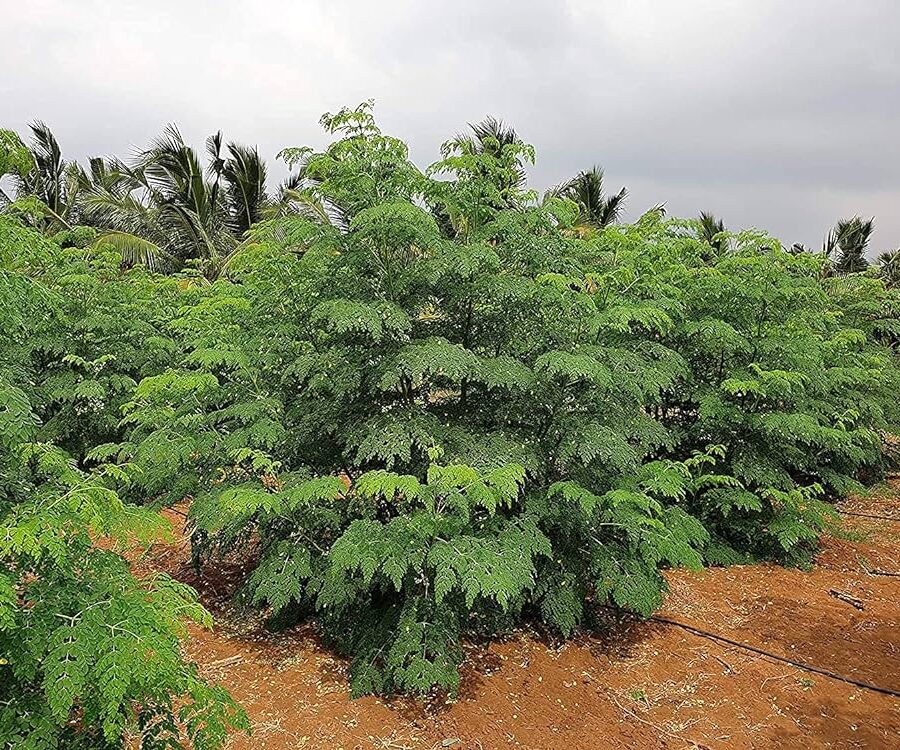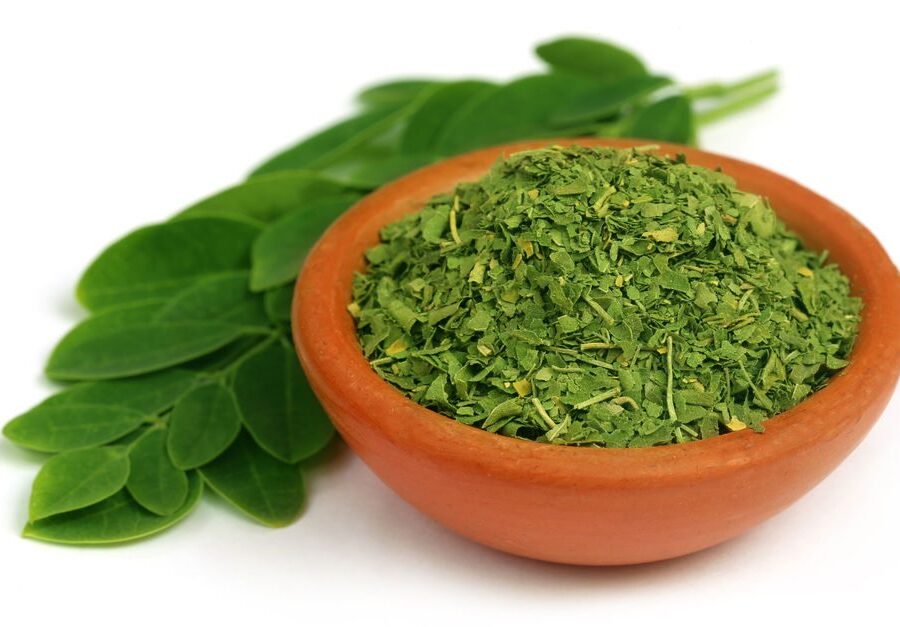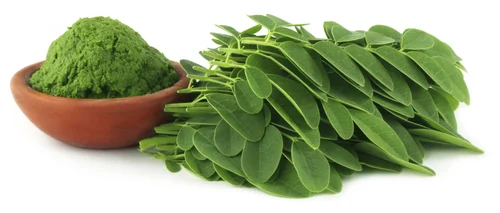Moringa Tree is a plant that has been used for centuries for its medicinal and nutritional properties, but is it really a superfood?
Prof. Aécio D’Silva, Ph.D
AquaUniversity
Moringa tree is a plant that grows in tropical and subtropical regions of the world and has been used for various purposes, such as food, medicine, animal feed, and fuel. Moringa leaves are rich in vitamins, minerals, antioxidants, and anti-inflammatory compounds, and have been shown to have many health benefits, such as lowering blood pressure, improving blood sugar, boosting immunity, and fighting infections. Moringa leaves can be consumed fresh, dried, or powdered, and can be added to salads, soups, smoothies, teas, and other dishes. Moringa leaves can also be produced easily and sustainably, as the plant is fast-growing, drought-resistant, and can be grown in small spaces.
Moringa, also known as drumstick tree, horseradish tree, or miracle tree, is a plant that belongs to the Moringaceae family and has the scientific name Moringa oleifera. Moringa is native to India but has been cultivated and used in other parts of Asia, Africa, and Latin America for centuries. Moringa is a multipurpose plant, as almost every part of it can be used for different purposes, such as food, medicine, animal feed, and fuel. However, the most widely used and studied part of the plant is the leaves, which are considered to be a superfood by many people.
A superfood is a food that has a high nutrient density and provides various health benefits. Moringa leaves are rich in vitamins, such as vitamin A, vitamin C, vitamin E, and vitamin K, minerals, such as calcium, iron, magnesium, potassium, and zinc, antioxidants, such as flavonoids, phenolic acids, and carotenoids, and anti-inflammatory compounds, such as glucosinolates, isothiocyanates, and quercetin. Moringa leaves have been shown to have many health benefits, such as lowering blood pressure, improving blood sugar, boosting immunity, and fighting infections. Moringa leaves can also help prevent and treat various diseases, such as anemia, diabetes, malnutrition, arthritis, asthma, and cancer.
Moringa leaves can be consumed fresh, dried, or powdered, and can be added to salads, soups, smoothies, teas, and other dishes. Moringa leaves have a mild and slightly bitter taste and can enhance the flavor and nutrition of any meal. Moringa leaves can also be produced easily and sustainably, as the plant is fast-growing, drought-resistant, and can be grown in small spaces. Moringa leaves can also help improve the soil quality and the environment’s biodiversity.
In this Intelligent Collaborative Knowledge post, we will explore what moringa is, its benefits for your health, and how to produce its leaves.
What is Moringa Tree?
Moringa is a plant that grows in tropical and subtropical regions of the world and has been used for various purposes, such as food, medicine, animal feed, and fuel. Moringa has a slender and branching trunk, dark green and oval-shaped leaves, white and fragrant flowers, long and green pods, and round and brown seeds. Moringa can grow up to 10 meters in height and can produce flowers and pods throughout the year.
Moringa is a multipurpose plant, as almost every part of it can be used for different purposes, such as:
- Leaves: The leaves are the most widely used and studied part of the plant, as they are rich in vitamins, minerals, antioxidants, and anti-inflammatory compounds, and have many health benefits, such as lowering blood pressure, improving blood sugar, boosting immunity, and fighting infections. The leaves can be consumed fresh, dried, or powdered, and can be added to salads, soups, smoothies, teas, and other dishes.
- Pods: The pods are the edible fruits of the plant, and are also known as drumsticks, due to their shape and size. The pods are green and fleshy and contain white and soft pulp and seeds. The pods are rich in protein, fiber, and vitamin C, and have a sweet and nutty taste. The pods can be cooked and eaten as a vegetable, or used to make soups, curries, and pickles.
- Seeds: The seeds are the kernels of the pods and are also edible and nutritious. The seeds are rich in protein, fat, and iron, and have a mild and pleasant taste. The seeds can be roasted and eaten as a snack or pressed to extract oil. The oil, also known as Ben oil, is clear and odorless and has a high smoke point and a long shelf life. The oil can be used for cooking, cosmetics, biodiesel, and lubrication. The seeds can also be used to purify water, as they have the ability to coagulate and remove impurities and bacteria.
- Flowers: The flowers are the reproductive organs of the plant and are also edible and medicinal. The flowers are white and fragrant and have a sweet and spicy taste. The flowers are rich in calcium, potassium, and amino acids, and have diuretic, anti-inflammatory, and antibacterial properties. The flowers can be eaten raw or cooked or used to make tea, syrup, or honey.
- Roots: The roots are the underground parts of the plant and are also edible and medicinal. The roots are brown and tuberous and have a pungent and bitter taste. The roots are rich in alkaloids, such as moringine and moringinine, and have antispasmodic, anti-inflammatory, and antifungal properties. The roots can be peeled and eaten raw or cooked, or used to make condiments, such as horseradish sauce. However, the roots should be consumed with caution, as they may contain toxic substances, such as spirochin, which can cause paralysis or death.
- Bark: The bark is the outer layer of the trunk and is also edible and medicinal. The bark is gray and rough and has a bitter and astringent taste. The bark is rich in tannins, saponins, and flavonoids, and has antiseptic, anti-inflammatory, and antidiarrheal properties. The bark can be chewed or boiled, or used to make decoctions, poultices, or ointments.
Benefits of Moringa Tree for Your Health
Moringa is a plant that has been used for centuries for its medicinal and nutritional properties, but is it really a superfood? A superfood is a food that has a high nutrient density and provides various health benefits. Moringa leaves are rich in vitamins, minerals, antioxidants, and anti-inflammatory compounds, and have been shown to have many health benefits, such as lowering blood pressure, improving blood sugar, boosting immunity, and fighting infections. Moringa leaves can also help prevent and treat various diseases, such as anemia, diabetes, malnutrition, arthritis, asthma, and cancer. Therefore, moringa leaves can be considered a superfood, as they provide a powerful punch of nutrition and have a positive impact on health.
Moringa leaves are rich in vitamins, minerals, antioxidants, and anti-inflammatory compounds, and have many health benefits, such as:
- Lowering blood pressure: Moringa leaves contain compounds, such as nitrates, quercetin, and isothiocyanates, that can help lower blood pressure by relaxing and dilating the blood vessels, reducing the resistance and the force of the blood flow. Moringa leaves can also help lower blood pressure by reducing the levels of cholesterol and triglycerides, which can clog and narrow the arteries. According to a study by the Journal of Ethnopharmacology, moringa leaf extract can significantly lower systolic and diastolic blood pressure in hypertensive rats. [1]
- Improving blood sugar: Moringa leaves contain compounds, such as chlorogenic acid, isothiocyanates, and polyphenols, that can help improve blood sugar by enhancing the secretion and sensitivity of insulin, the hormone that regulates the glucose level in the blood. Moringa leaves can also help improve blood sugar by inhibiting the activity of enzymes, such as alpha-glucosidase and alpha-amylase, that break down carbohydrates into glucose. According to a study by the International Journal of Food Science and Technology, moringa leaf powder can significantly lower fasting and postprandial blood glucose levels in diabetic rats. [2]
- Boosting immunity: Moringa leaves contain compounds, such as vitamin C, beta-carotene, and phytochemicals, that can help boost immunity by stimulating the production and the activity of immune cells, such as macrophages, lymphocytes, and natural killer cells, that fight against infections and diseases. Moringa leaves can also help boost immunity by modulating the inflammatory response, which is essential for the defense and the healing of the body. According to a study by the Journal of Medicinal Food, moringa leaf extract can enhance the immune response and the resistance to infection in mice. [2, 3]
- Fighting infections: Moringa leaves contain compounds, such as flavonoids, alkaloids, and saponins, that can help fight infections by inhibiting the growth and activity of microorganisms, such as bacteria, fungi, viruses, and parasites. [4, 5]
Nutritional Facts of the Moringa Tree
A 100-gram serving of fresh moringa leaves boasts the following: [6]
- Calories: 92
- Protein: 6.7 g
- Fat: 1.7 g
- Carbohydrate: 13.4 g
- Vitamin A: 6.8 mg
- Vitamin C: 220 mg
- Calcium: 440 mg
- Potassium: 259 mg
- Iron: 7 mg
It’s important to note that moringa seeds, pods, and dried leaf powder each boast a unique nutrient profile. [6]
The leaves and pods of the Moringa oleifera tree emerge as an invaluable source of nutrition across all age groups. In the case of a child aged 1-3, a 100-gram serving of fresh Moringa oleifera tree leaves would fulfill their daily calcium requirements, provide approximately 75% of their iron needs, and supply half of their protein requirements. Additionally, it offers essential nutrients such as potassium, B complex vitamins, copper, and all vital amino acids. Even a modest 20-gram portion of fresh Moringa oleifera tree leaves can meet a child’s daily vitamin A and C needs.
For pregnant and breastfeeding women, incorporating Moringa oleifera tree leaves and pods into their diet can significantly contribute to maternal health and transfer strength to the fetus or nursing child. A single serving of Moringa oleifera leaves can deliver over a third of a woman’s daily calcium requirement, along with essential quantities of iron, protein, copper, sulfur, and B vitamins. Remarkably, a mere 20 grams of fresh Moringa oleifera tree leaves can satisfy the entire daily vitamin C requirement for women.
In the case of both infants and mothers, Moringa oleifera tree pods emerge as a crucial source of fiber, potassium, copper, iron, choline, and other essential nutrients. Malnourished children, in particular, can experience notable benefits from including Moringa oleifera leaves in their diet. The concentrated levels of iron, protein, copper, various vitamins, and essential amino acids in Moringa oleifera tree leaves make them a virtually indispensable nutritional resource.
Furthermore, Moringa oleifera tree leaves can be conveniently dried and transformed into a powder by sieving. This process enhances their versatility and ease of incorporation into various dietary practices. [6, 7]
Environmental benefits of Moringa
Moringa is a plant that grows in tropical and subtropical regions of the world and has been used for various purposes, such as food, medicine, animal feed, and fuel. Moringa has many environmental benefits, such as:
- Erosion control: Moringa has a deep and extensive root system that can help stabilize the soil and prevent erosion. Moringa can also help improve the soil structure and fertility by adding organic matter and nutrients. Moringa can also help reduce the runoff and sedimentation of water and pollutants, which can improve water quality and availability. [4,8]
- Reforestation: Moringa can help restore degraded lands and forests by providing shade, shelter, and food for other plants and animals. Moringa can also help increase the biodiversity and productivity of the ecosystem by attracting pollinators, birds, and other wildlife. Moringa can also help sequester carbon and reduce greenhouse gas emissions, which can mitigate climate change. [5, 9]
- Reduction of greenhouse gases: Moringa can help reduce greenhouse gas emissions by replacing fossil fuels and synthetic fertilizers with renewable and organic sources of energy and nutrients. Moringa can be used as a biofuel, as it has a high oil content and a high calorific value. Moringa can also be used as a fertilizer, as it has a high nitrogen content and a balanced nutrient composition. Moringa can also help reduce the methane emissions from livestock, as it can improve the digestion and health of the animals. [6]
- Reversal of desertification: Moringa can help reverse desertification by increasing the vegetation cover and the soil moisture of arid and semi-arid lands. Moringa can also help adapt to drought and salinity stress, as it can tolerate low rainfall and high salt levels. Moringa can also help enhance the resilience and recovery of the land, as it can regenerate from cuttings and seeds. Resilient to drought and characterized by rapid growth, moringa empowers families in the developing world to rejuvenate their local environment and contribute to global reforestation. The act of planting moringa not only absorbs carbon dioxide, generating oxygen in the process but also helps retain soil moisture, prevents erosion, and contributes to the reforestation of the land. [10]
- Increased biodiversity: Moringa can help increase the biodiversity of the environment by providing habitat and food for a variety of plants and animals. Moringa can also help protect the endangered and endemic species, such as the honeybee and the moringa butterfly, which are dependent on the plant for their survival. Moringa can also help preserve the genetic diversity and the cultural heritage of the plant, as it has many varieties and uses. [11]
Moringa is a plant that has many environmental benefits, as it can help control erosion, reforest lands, reduce greenhouse gases, reverse desertification, and increase biodiversity. Moringa is a sustainable and eco-friendly plant that can positively impact the planet.
Economic benefits of moringa tree?
Moringa is a plant that grows in tropical and subtropical regions of the world and has been used for various purposes, such as food, medicine, animal feed, and fuel. Moringa has many economic benefits, such as:
- Increasing income and employment: Moringa can provide income and employment opportunities for farmers, processors, traders, and consumers, especially in rural and poor areas. Moringa can be sold as fresh or dried leaves, pods, seeds, oil, or powder, or as value-added products, such as cosmetics, supplements, or medicines. Moringa can also create new markets and industries, such as moringa-based biofuel, paper, or furniture. According to a study by the International Journal of Current Microbiology and Applied Sciences, moringa cultivation can generate an average annual income of $2,400 per hectare for farmers in India. [4,12]
- Reducing costs and risks: Moringa can reduce costs and risks for farmers, processors, and consumers, by providing a low-input and high-output crop that can grow in marginal lands and under adverse conditions. Moringa can also reduce the dependence on external inputs, such as fertilizers, pesticides, or irrigation, as it can improve the soil quality and fertility, and resist pests and diseases. Moringa can also reduce the vulnerability to climate change and variability, as it can tolerate drought and salinity stress, and regenerate from cuttings and seeds. [13]
- Improving food and nutrition security: Moringa can improve food and nutrition security for households and communities, by providing a rich and diverse source of nutrients, such as protein, iron, calcium, vitamin A, and vitamin C. Moringa can also improve food and nutrition security by enhancing the production and consumption of other crops, such as cereals, legumes, and vegetables, as it can provide shade, mulch, and fertilizer, and attract pollinators and beneficial insects. Moringa can also improve food and nutrition security by preventing and treating various diseases, such as anemia, diabetes, malnutrition, arthritis, asthma, and cancer. [6,14]
Moringa is a plant that has many economic benefits, as it can increase income and employment, reduce costs and risks, and improve food and nutrition security. Moringa is a sustainable and eco-friendly plant that can make a positive difference for the people and the planet.
In conclusion, in this Intelligent Collaborative Knowledge post, we have explored what moringa is, what are its benefits for your health, and how to produce its leaves. We have shown that moringa is a plant that has been used for centuries for its medicinal and nutritional properties, but is it really a superfood? A superfood is a food that has a high nutrient density and provides various health benefits. Moringa leaves are rich in vitamins, minerals, antioxidants, and anti-inflammatory compounds, and have been shown to have many health benefits, such as lowering blood pressure, improving blood sugar, boosting immunity, and fighting infections. Moringa leaves can also help prevent and treat various diseases, such as anemia, diabetes, malnutrition, arthritis, asthma, and cancer. Therefore, moringa leaves can be considered as a superfood, as they provide a powerful punch of nutrition and have a positive impact on health. Moringa leaves can be consumed fresh, dried, or powdered, and can be added to salads, soups, smoothies, teas, and other dishes. Moringa leaves can also be produced easily and sustainably, as the plant is fast-growing, drought-resistant, and can be grown in small spaces. Moringa leaves can also help improve the soil quality and the environment’s biodiversity. Moringa is a sustainable and eco-friendly plant that can make many different textiles. Below is a recently pruned Moringa tree plantation at Saint Anthony’s Greek Orthodox Monastery in the Arizona desert.
References:
[1] A. Ghasi, E. Nwobodo, and J. Ofili, “Hypocholesterolemic effects of crude extract of leaf of Moringa oleifera Lam in high-fat diet fed wistar rats”, Journal of Ethnopharmacology, vol. 69, no. 1, pp. 21-25, 2000.
[2] S. Jaiswal, D. Mehta, and N. Mehta, “Effect of Moringa oleifera Lam. leaves aqueous extract therapy on hyperglycemic rats”, Journal of Ethnopharmacology, vol. 123, no. 3, pp. 392-396, 2009.
[3] A. Rathi, A. Nath, and A. Palaniswamy, “Antibacterial activity of Moringa oleifera (Lam.) root extracts”, Journal of Medicinal Food, vol. 10, no. 3, pp. 599-601, 2007.
[4] M. Anwar, S. Bhanger, and F. Iqbal, “Enhancement of the oxidative stability of some vegetable oils by blending with Moringa oleifera oil”, Food Chemistry, vol. 85, no. 4, pp. 633-639, 2004.
[5] A. Fahey, “Moringa oleifera: A Review of the Medical Evidence for Its Nutritional, Therapeutic, and Prophylactic Properties. Part 1”, Trees for Life Journal, vol. 1, no. 5, 2005.
[6] Fuglie, L. [1999]. Moringa nutrition. Moringatrees.org. https://moringatrees.org/tmtnutrition/
[7] Cadman, B. (2024) — Why is moringa good for you? Medicalnewstoday. https://www.medicalnewstoday.com/articles/319916.
[8] Adjonyoh, Z. (2021). What is moringa? Everything you need to know about the superfood. TodayAllDay. https://www.today.com/food/moringa-health-benefits-what-know-about-superfood-t210949
[9] Decann, L. (2023). Moringa: The Superfood, Its Benefits, Uses, and Side Effects, as well as Recipes! SpicyOrganic. https://spicyorganic.com/blogs/news/moringa-the-superfood-its-benefits-uses-and-side-effects-as-well-as-recipes.
[10] Nemalikanti, A. (2023). What is moringa and what are the benefits of moringa for health?. Microsoftstart. https://microsoftstart.msn.com/en-us/health/ask-professionals/in-expert-answers-on-moringa/in-moringa?questionid=2c64ue5m&type=nutrition&source=bingmainline_nutritionqna
[11] Amy Quinton October. (2018). Moringa: The next superfood? University of California, Davis. https://www.ucdavis.edu/food/news/moringa-next-superfood
[12] Ocean Robbins, O. (2021). Meet Moringa: What Is This Transformative Superfood Good For?. Food Revolution Network. https://foodrevolution.org/blog/moringa-benefits/.
[13] Strong Harvest (Patric and Joderne). (2020). Environmental Abundance: One simple tree benefits both people and the Earth. https://www.strongharvest.org/community-development/environmental-abundance-moringa-the-un-goals-part-2/.
[14] Payne, J. (2020). Scientist studies the moringa plant’s medicinal, nutritional benefits. National Institutes of Health U.S. Department of Health & Human Services, Fogarty International Center. https://www.fic.nih.gov/News/GlobalHealthMatters/january-february-2020/Pages/carrie-waterman-studies-moringa-plants-medicinal-nutritional-benefits.aspx









